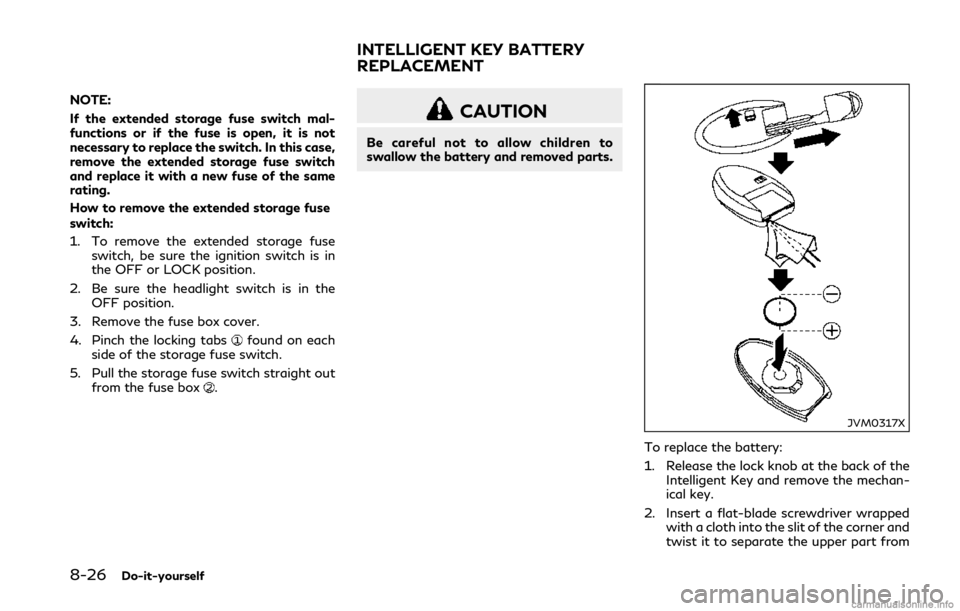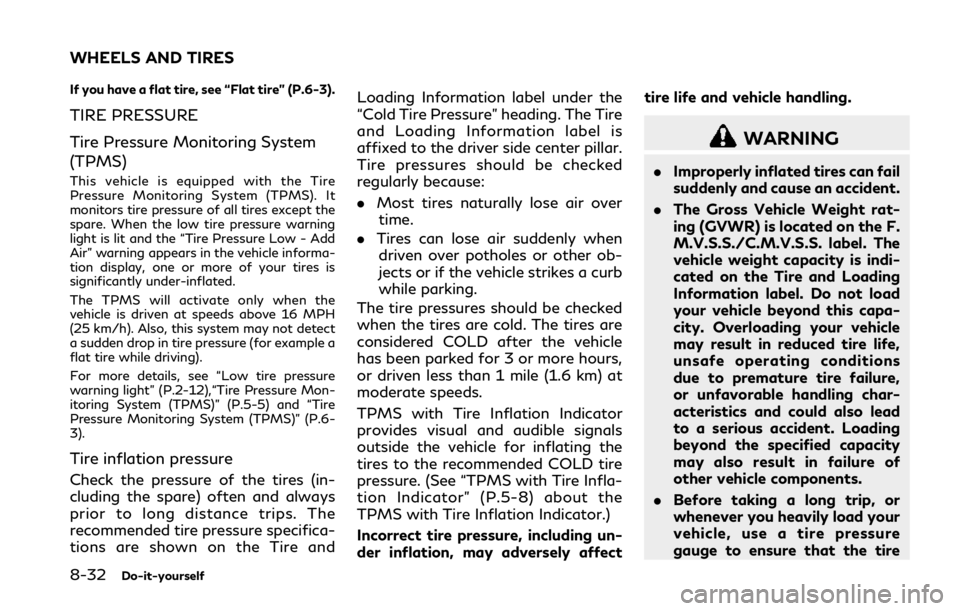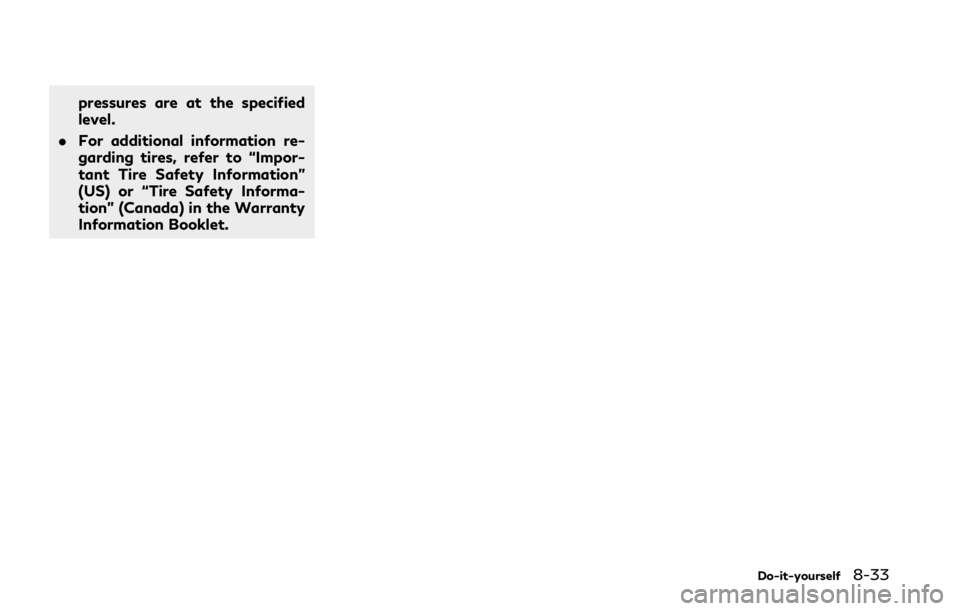INFINITI Q50 2018 Owner's Manual
Manufacturer: INFINITI, Model Year: 2018, Model line: Q50, Model: INFINITI Q50 2018Pages: 458, PDF Size: 2.13 MB
Page 381 of 458

8-26Do-it-yourself
NOTE:
If the extended storage fuse switch mal-
functions or if the fuse is open, it is not
necessary to replace the switch. In this case,
remove the extended storage fuse switch
and replace it with a new fuse of the same
rating.
How to remove the extended storage fuse
switch:
1. To remove the extended storage fuseswitch, be sure the ignition switch is in
the OFF or LOCK position.
2. Be sure the headlight switch is in the OFF position.
3. Remove the fuse box cover.
4. Pinch the locking tabs
found on each
side of the storage fuse switch.
5. Pull the storage fuse switch straight out from the fuse box
.
CAUTION
Be careful not to allow children to
swallow the battery and removed parts.
JVM0317X
To replace the battery:
1. Release the lock knob at the back of theIntelligent Key and remove the mechan-
ical key.
2. Insert a flat-blade screwdriver wrapped with a cloth into the slit of the corner and
twist it to separate the upper part from
INTELLIGENT KEY BATTERY
REPLACEMENT
Page 382 of 458

the lower part.
3. Replace the battery with a new one. Recommended battery:
CR2032 or equivalent
.Do not touch the internal circuit andelectric terminals as it could cause a
malfunction.
.Hold the battery by the edges. Hold-
ing the battery across the contact
points will seriously deplete the sto-
rage capacity.
.Make sure that the + side faces thebottom of the case.
SDI2452
4. Align the tips of the upper and lower
parts, and then push them togetheruntil it is securely closed.
5. Operate the buttons to check its opera- tion.
If you need any assistance for replacement,
it is recommended you visit an INFINITI
retailer for this service.
FCC Notice:
For USA:
This device complies with Part 15 of the
FCC Rules. Operation is subject to the
following two conditions: (1) This device
may not cause harmful interference, and (2)
this device must accept any interference received, including interference that may
cause undesired operation.
NOTE:
Changes or modifications not expressly
approved by the party responsible for
compliance could void the user’s authority
to operate the equipment.
For Canada:
This device complies with Industry Canada
licence-exempt RSS standard(s). Operation
is subject to the following two conditions:
(1) this device may not cause interference,
and (2) this device must accept any inter-
ference, including interference that may
cause undesired operation of the device.
Do-it-yourself8-27
Page 383 of 458

8-28Do-it-yourself
JVM0828X
1. Headlight (high-beam)
2. Headlight (low-beam)
3. Parking light, daytime running light
4. Map light
5. Rear personal light
6. Side turn signal light
7. Front turn signal light
8. Fog light
9. Front side marker light
10. Step light
11. Courtesy light
12. High-mounted stop light
13. Back-up light
14. Tail light
15. Rear turn signal light
16. Tail/stop light
17. Rear side marker light
18. License plate light
19. Trunk light
LIGHTS
Page 384 of 458

HEADLIGHTS
If replacement is required, it is recommended
you visit an INFINITI retailer for this service.
Fog may temporarily form inside the lens of
the exterior lights in the rain or in a car wash.
A temperature difference between the inside
and the outside of the lens causes the fog.
This is not a malfunction. If large drops of
water collect inside the lens, it is recom-
mended you visit an INFINITI retailer for this
service.
EXTERIOR AND INTERIOR LIGHTS
ItemWattage (W)Bulb No.
Headlight* High/Low beams LED—
Front turn signal light* LED—
Front fog light* LED—
Parking light*/Daytime running light* LED—
Front side marker light* LED—
Side turn signal light* LED—
Rear combination light* back-up LED—
turn signal LED—
tail LED—
tail/stop LED—
side marker LED—
License plate light* LED—
Map light* LED—
Rear personal light 8—
Vanity mirror light* 1.8—
Step light 5—
Console box light* 2—
Inside door handle light* (if so equipped) LED—
Door trim light* (if so equipped) LED—
Front cup holder light* LED—
Footwell light* LED—
Trunk light 3.4—
Do-it-yourself8-29
Page 385 of 458

8-30Do-it-yourself
ItemWattage (W)Bulb No.
Courtesy light* LED—
High-mounted stop light* LED—
*: It is recommended you visit an INFINITI retailer for replacement.
NOTE: It is recommended that you check with the Parts Department at an INFINITI retailer
for the latest information about parts.
Replacement procedures
All other lights are either type A, B, C, D, E or
F. When replacing a bulb, first remove the
lens and/or cover.
Page 386 of 458

SDI1679
SDI2031
Rear personal light
SDI2330
Step light
SDI1258A
Trunk light
Do-it-yourself8-31
Page 387 of 458

8-32Do-it-yourself
If you have a flat tire, see “Flat tire” (P.6-3).
TIRE PRESSURE
Tire Pressure Monitoring System
(TPMS)
This vehicle is equipped with the Tire
Pressure Monitoring System (TPMS). It
monitors tire pressure of all tires except the
spare. When the low tire pressure warning
light is lit and the “Tire Pressure Low - Add
Air” warning appears in the vehicle informa-
tion display, one or more of your tires is
significantly under-inflated.
The TPMS will activate only when the
vehicle is driven at speeds above 16 MPH
(25 km/h). Also, this system may not detect
a sudden drop in tire pressure (for example a
flat tire while driving).
For more details, see “Low tire pressure
warning light” (P.2-12),“Tire Pressure Mon-
itoring System (TPMS)” (P.5-5) and “Tire
Pressure Monitoring System (TPMS)” (P.6-
3).
Tire inflation pressure
Check the pressure of the tires (in-
cluding the spare) often and always
prior to long distance trips. The
recommended tire pressure specifica-
tions are shown on the Tire andLoading Information label under the
“Cold Tire Pressure” heading. The Tire
and Loading Information label is
affixed to the driver side center pillar.
Tire pressures should be checked
regularly because:
.
Most tires naturally lose air over
time.
. Tires can lose air suddenly when
driven over potholes or other ob-
jects or if the vehicle strikes a curb
while parking.
The tire pressures should be checked
when the tires are cold. The tires are
considered COLD after the vehicle
has been parked for 3 or more hours,
or driven less than 1 mile (1.6 km) at
moderate speeds.
TPMS with Tire Inflation Indicator
provides visual and audible signals
outside the vehicle for inflating the
tires to the recommended COLD tire
pressure. (See “TPMS with Tire Infla-
tion Indicator” (P.5-8) about the
TPMS with Tire Inflation Indicator.)
Incorrect tire pressure, including un-
der inflation, may adversely affect tire life and vehicle handling.
WARNING
.
Improperly inflated tires can fail
suddenly and cause an accident.
. The Gross Vehicle Weight rat-
ing (GVWR) is located on the F.
M.V.S.S./C.M.V.S.S. label. The
vehicle weight capacity is indi-
cated on the Tire and Loading
Information label. Do not load
your vehicle beyond this capa-
city. Overloading your vehicle
may result in reduced tire life,
unsafe operating conditions
due to premature tire failure,
or unfavorable handling char-
acteristics and could also lead
to a serious accident. Loading
beyond the specified capacity
may also result in failure of
other vehicle components.
. Before taking a long trip, or
whenever you heavily load your
vehicle, use a tire pressure
gauge to ensure that the tire
WHEELS AND TIRES
Page 388 of 458

pressures are at the specified
level.
. For additional information re-
garding tires, refer to “Impor-
tant Tire Safety Information”
(US) or “Tire Safety Informa-
tion” (Canada) in the Warranty
Information Booklet.
Do-it-yourself8-33
Page 389 of 458

8-34Do-it-yourself
SDI2567
Tire and Loading Information label
Seating capacity: The maximum
number of occupants that can be
seated in the vehicle.
Vehicle load limit: See “Vehicle
loading information” (P.10-19).
Original size: The size of the tires
originally installed on the vehicle
at the factory.
Cold tire pressure: Inflate the
tires to this pressure when the
tires are cold. Tires are consid-ered COLD after the vehicle has
been parked for 3 or more hours,
or driven less than 1 mile (1.6 km)
at moderate speeds. The recom-
mended cold tire inflation is set
by the manufacturer to provide
the best balance of tire wear,
vehicle handling, driveability, tire
noise, etc., up to the vehicle’s
GVWR.
Tire size — see “Tire labeling”
(P.8-36).
Spare tire size or compact spare
tire size (if so equipped)
Page 390 of 458

SDI1949
Checking the tire pressure
1. Remove the valve stem cap fromthe tire.
2. Press the pressure gauge squarely onto the valve stem. Do not press
too hard or force the valve stem
sideways, or air will escape. If the
hissing sound of air escaping from
the tire is heard while checking the
pressure, reposition the gauge to
eliminate this leakage.
3. Remove the gauge. 4. Read the tire pressure on the
gauge stem and compare it to the
specification shown on the Tire
and Loading Information label.
5. Add air to the tire as needed. If too much air is added, press the core of
the valve stem briefly with the tip
of the gauge stem to release
pressure. Recheck the pressure
and add or release air as needed.
6. Install the valve stem cap.
7. Check the pressure of all other tires, including the spare.
SIZE COLD
TIRE IN- FLA-
TION
PRES- SURE
FRONT ORIGI- NAL
TIRE P225/55R-
F17 95V
240 kPa,
35 PSI
P225/50R-
F18 94V 240 kPa,
35 PSI
P245/40R-
F19 94V 240 kPa,
35 PSI
245/40RF19
94W 240 kPa,
35 PSI
245/40R19
94Y 240 kPa,
35 PSI
Do-it-yourself8-35